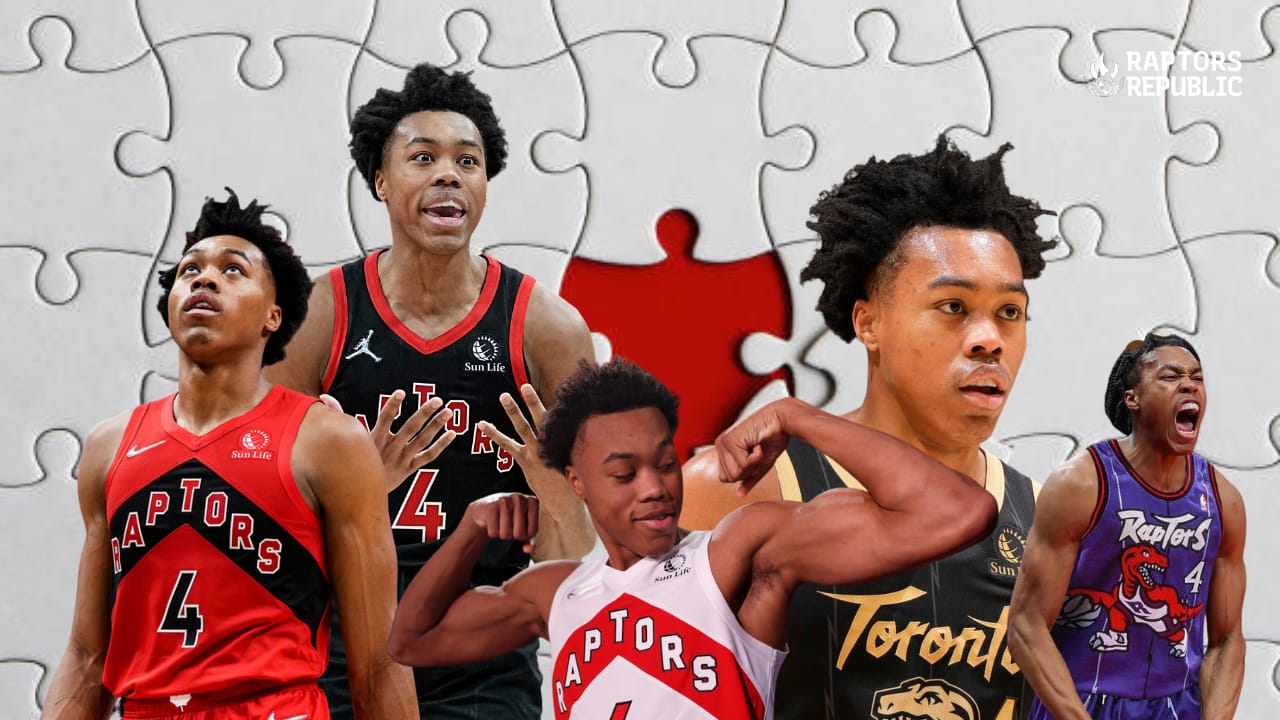Tempo as a tool is best employed, broadly across human endeavoring, by the most maniacal among us. Think horror-movie suspense, late-career Chris Paul, or J.K. Simmons in Whiplash. The best know when to drag, and when to rush, and when to leave our stomachs in a lurch by doing either. And, after his masterpiece against the Milwaukee Bucks, we can add Scottie Barnes to the list of “the best,” or at least on his way to it.
This is my third Diary of a Genius entry about Scottie Barnes. The idea is to show how Barnes doesn’t just do something brilliant in a single, defined area of the game, but also how he uses his brilliancy in one momentary area to open up another approach later in the same space. Think when Scottie Barnes used a skip pass to, on the next possession, open a lane for a bullet pass underneath the rim, documented in the inaugural Diary of a Genius piece on his passing. The second entry was on his finishing. This will be different. (In part because I considered using Arnold Schoenberg as the lede again here because, you know, tempo, but I thought it might be too on the nose.)
Getting anywhere you want on the court can be done in so, so many ways. You can just be faster than anyone else. You can dribble the ball in ways that leave defenders in the wrong places, that leave them grasping and gasping for air. You can be so good at shooting that defenders simply throw their bodies at you 30 feet from the hoop like extras in a war movie.
Barnes of course has none of those qualities, not yet. So how can he get where he wants to on the basketball court? How does he dribble the ball from behind the 3-point line to the rim? Previously in his career, he rarely did outside of transition. But he was able to, and frequently, against the Bucks by opting for the most devilish way to move himself around the court.
You can be a maniac. You can hold onto the punch line for much, much longer than you need to, wrong-footing your audience. (Norm MacDonald.) You can rush past your punch line breathlessly, leaving your audience a step behind, marveling. (Anthony Jesselnik.) Selecting either option at its extremity is the realm of a sicko. The realm of Scottie Barnes.
In the first quarter against the Bucks, Barnes started contributing immediately. His jumper was compact and without hesitation, as it was all night, leading him to finish the game shooting a tight 3-of-3 from behind the arc. In a sense, shooting without hesitation is a form of tempo, but we’re going to get much, much deeper, here. Corner triples from Barnes — thought he only attempts a miniscule 5 percent of his shots from the region — are a revelation. His success there is meaningful, both for his own efficiency and for his ability to stretch the court to its full width for his teammates. (They did not take advantage against Milwaukee.)
Still, for Barnes to cash his jumpers is significant; this is what Siakam saw on his drive.
That’s a whole lot of advantage-creation by Siakam. And it’s on Barnes to turn that into points on the board. He did. (Barnes is quietly shooting 34.8 percent on triples from the corner in his career, much higher than his 30.0 percent overall.)
However, the majority of Barnes’ work is done as a creator. Only a few moments later he sets the tempo by which his metronome will tick for the remainder of the game. He sets it slow, intermittent, letting the ticks ring out in between his pacing.
It is sometimes best for great athletes to move slowly. The best players move at multiple speeds, and it’s generally more intuitive to speed up than it is to slow down. (Those who can slow down with force, like James Harden, can make a career out of it.) But the best players will often set their metronomes slow, keeping their power coiled at all times, threatening to erupt. From such suspense can ulcers, or pick-and-roll masterpieces, be born.
That’s less a dime (not one at all) than a flag in the ground, stating ‘this is my tempo.’ Defenders become accustomed to that, however, so Barnes very quickly uses their expectations to his advantage. He takes another high pick-and-roll touch, again reaching the paint — Milwaukee goes over picks, giving Barnes an advantage there. Once again, Barnes has his primary defender on his hip and the big defender in front of him. Once again, he slows down, thus engaging the big — who just saw him find an internal passing lane doing this — and bringing the tagger closer to the paint to close the lane for the lay-down. Then Barnes uncoils his slinky, slinging the ball to a completely uncontested weak corner. His pacing creates extra space for Malachi Flynn upon the catch.
He keeps the chains moving, piling tempo tricks on top of tempo tricks on his very next touch. Another pick-and-roll touch, another drive, another paint touch, another early pickup. So far, so much the same on three consecutive possessions. First, he laid down the ball to his big. Then he sprayed it to the corner. Because of his passing, defenders are more at home than usual, leaving him a relatively uncrowded (for Toronto, so, still crowded) paint. So he stays slow and jumps early, getting thin in midair, and leaping around the big for the finish on the other side of the rim.
That’s like having three different pitches with identical arm angles. Slow-fast-slow. Pass-pass-shot. Barnes is a chess player, attacking with his brain as much as his body. He is a wave, a breath, a heartbeat.
Later he creates an open shot for a teammate by rejecting a screen, but no shot comes. So he does it himself, jetting into a give-and-go, looping around the court, staying in first gear, directing the defense here, then there, before finishing with a Statue-of-Liberty hook layup that only Barnes would consider.
It helps when defenders bite on your pump fake, which is helped by your hitting your triples. Success in one space manifests in others.
Barnes finally lets the Ferrari onto the highway. To this point, he has been mostly Norm MacDonald, crawling into his jokes. He finally sprints so far down the runway that the audience doesn’t even have a chance to laugh before he’s already onto the next setup. (Complete with the push-off.) Of course, Precious Achiuwa passes up the uncontested jumper to dribble into a significantly worse look.
He takes his tempo to the post, where first he rushes — into an offensive foul. Then he dribbles into a post in the identical spot on the floor and drags on the off beat — with his defender expecting the body blow, the crash, he spins the opposite way and jumps to engage the help defense before laying the ball down to his big. Who drops the ball.
(If you can’t tell, Barnes’ brilliance going unrewarded by his teammates is a commonality here.)
Then he hits the brakes. Slow, slow, slow. A lofting hook without turning his hips, followed by a monstrous stride length to hit the middle of the floor. Both times he moves so slowly, and shoots with no preparation, meaning there is no contest from flat-footed defenders. He puts his defender in jail again by slowing down, this time laying down to his big for free throws. Now he makes his original metronome seem fast, so methodically does he ooze from place to place,
Then he accelerates. He stampede cuts, smashing into Brook Lopez in midair. The next play, he slows, drawing Lopez as a defender before dumping off to Poeltl, slipping the pass around the double yet outside the reach of the tag. When moving fast or slow, Barnes almost never misses a passing window. His last touch of the game, he ambles into a screen, slowly drags away a switch for the post, seals, catches over the top, and in the process draws the entire defense. So far he hasn’t moved outside of normal walking speed, so he turns and leaps again and hurtles a pass to a rim-running Poeltl. His frenetic pace change creates an uncontested shot for Toronto, but the possession, again, ends in no points.
Plenty of players have been able to get to their spots without top-end speed or handles. Paul Pierce was one of LeBron James’ earliest foils, and he made his career out of pacing and leaning jumpers. Barnes, perhaps more than in any of his games I have seen, or at least can remember, found himself waltzing, fast or slow, anywhere he liked against Milwaukee. It helped that Milwaukee went over his screens. It helped that Giannis Antetokounmpo didn’t play. But most of all, it helped that Barnes had long-term plans and stuck to them on seemingly every possession. He used his previously established pacing to wrong-foot defenders the next time around. He mixed up his habits. He dragged and rushed and danced up and down the beats, finding slivers of space between notes.
Ball may or may not be life, but the best ball is played by mimicking life. Of course, that’s the only natural way to do anything. But the best basketball breathes — in, and out. If you only inhale, only move slowly, you’ll never get anywhere. If you only exhale, only rush, you’ll be benched for Killian Hayes. Barnes has many, many skills on the basketball court, but tempo has rarely been one of his best. He has spent too many games holding his breath. Not against Milwaukee. Against the Bucks, he rode the wave, up and down, wherever it took him.
It’s important to note that the performance did not take Toronto to a win. Players bobbled Barnes’ passes, missed open jumpers, and generally did not come along for the ride. Barnes is great at turning good into great on the basketball court, and he created great shots for seemingly everyone. And yet the Raptors shot 9-of-33 from deep (27.3 percent). Excluding Barnes, it was 6-of-30 (20 percent).
Barnes still finished with a team-high 7 assists. Toronto still scored 112 points, which should have been enough to win the game had it been playing much of any defense. And Barnes was guilty on that end, too. But the greatest pacing trick Barnes performed was leading the Raptors to an average offensive game while they seemingly missed every shot they took. That’s not tempo as much as dark magic.
It’s reasonable to call Barnes a magician. He has the flair, the aesthetics: the lookaway passes and dunks. And a good magic show uses tempo to lure viewers everywhere the magician wants — to look left when the trick happens right, to stand up when the trick is under the seat, to gasp when the card is revealed. Barnes did the same to Milwaukee, luring defenders to the right spots just as he paced his marks on the stage. Toronto lost, but wins and losses happen all the time. They are commonplace. Barnes did something we haven’t seen from him before, not to this extent. He added yet more to his game. Just another stop on his inexorable march to stardom.



